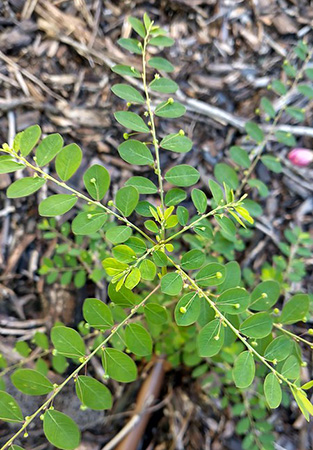Chamberbitter

Chamberbitter is the common name for two weeds that have invaded our Florida landscapes. Non-native to Florida, these plants hail from the tropical regions of Africa and Asia. Both are warm-season plant pests, broad-leaved, and found throughout the state.
Removing chamberbitter from your landscape will be a marathon, not a sprint. Read on for ways to identify and manage both species.
Identification
Chamberbitters are referred to by a host of descriptive common names, including "shatterstone" and "gripeweed." Many gardeners call both species by their genus name, Phyllanthus. For the purposes of this article we will refer to Phyllanthus urinaria as "gripeweed." Phyllanthus tenellus we will call "long-stalked chamberbitter."
Both chamberbitter species are easily identified by their mimosa-like leaves and characteristic seed pods. Chamberbitter leaves are compound, with rounded leaflets growing on a long, stem-like part of the plant called an axil. The flowers are small and inconspicuous, distributed evenly along the axil. The plants produce flowers quickly and fruits follow soon after. When the fruits mature, they shatter explosively, scattering seeds far and wide.
Gripeweed is the shorter, more compact chamberbitter. It rarely grows above 12 inches tall. Its short stature makes it very difficult to control. It flourishes at grass height, and mowing does very little to check the progress of this weed. Gripeweed can reproduce even if it is kept at a height of 2 inches. The fruits are less conspicuous because they're attached directly to the leaf axil and hidden by crowded leaflets.
Long-stalked chamberbitter grows up to 2 feet tall. In home landscapes you usually see it under 12 inches tall, but the stem is still much longer and less branched than short-stemmed chamberbitter. The leaflets of long-stalked chamberbitter are less crowded than those of its shorter cousin. The flowers and fruits grow on short stems, called pedicels.
Management
Both species grow in the same environments and have very similar biology. Once they start to develop a woody base they can be very difficult to control, even with herbicides. Chamberbitter wastes no time in reproducing, either. They and their seedlings do best in moist environments. If it is possible, decreasing your irrigation is a helpful cultural control. As always, healthy, well-maintained turf is the best defense against weeds like chamberbitter. Check your nursery pots before planting, too. Chamberbitter is a common nursery weed.
If you choose to manage these weeds by hand-pulling (another cultural control), scout often and pull them as soon as you notice them. Once the mature plants are removed, a thick layer of mulch is effective in keeping chamberbitter out of landscape beds. Apply your mulch 2-3 inches thick and weed as needed.
For more significant infestations and on large plots, chemical control may be your best choice for controlling chamberbitter. As we noted before, chamberbitter is very difficult to control once it develops a woody stem; if you plan to spray, do it sooner rather than later. For preemergence and post emergence herbicide recommendations and regulations, contact your county Extension office or the UF/IFAS Pesticide Information Office. Always remember, the label is the law.
For more information about controlling weeds in your landscape contact your county Extension office.
Also on Gardening Solutions
More from UF/IFAS
- Have You Seen This Weed? Chamberbitter--UF/IFAS Blogs
- Phyllanthus urinaria--UF/IFAS Assessment of Non-Native Plants in Florida's Natural Areas
- Phllanthus urinaria, Chamberbitter--Weed ID by Flower Color, Mid-Florida Research & Education Center
- Weed Management Guide for Florida Lawns
- Weed Spotlight: Chamberbitter, the "Little Mimosa"--UF/IFAS Blogs

